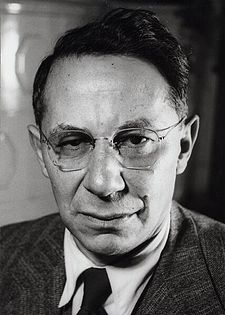Prominent Poles
Tadeusz Reichstein (aka Tadeus Reichstein) Polish-Jewish- Swiss chemical engineer,inventor, Nobel prize in Physiology or Medicine,1950.

Born: July 20, 1897 in Wloclawek, Russian partition of Poland (presently Poland).
Died: August 1, 1996 in Basel, Switzerland.
Early days. Reichstein was born into a Jewish family at Wloclawek, Congress Poland. His father, Izydor, was an engineer, his mother- Gustawa nee Brockman. Reichstein spent his early childhood at Kiev, Russia (presently Kyiv, Ukraine), where his father got a job. He began his education at boarding-school in Jena, Germany. In 1906 his family emigrated to Zurich, Switzerland where he first went to a private tutor and later to the Oberrealschule (technical school of junior college grade) and finally to the Eidgenossische Technische Hochschule (E.T.H.) (State Technical College) getting a diploma in 1920. He got a doctorate (PhD) in 1922 and began research under Professor Staudinger at E.T.H.
Career. From 1930 till 1938 he was professor of organic chemistry at ETH and from 1946 till 1967-at the University of Basel. In 1933, working in Zurich, Switzerland, Reichstein succeeded, independently of Sir Norman Haworth and his collaborators in the United Kingdom, in synthesizing in 1933 vitamin C (ascorbic acid) in what is now called the Reichstein process. In 1934 he was appointed Titular Professor, in 1937 Associate Professor, and in 1938 Professor in Pharmaceutical Chemistry, and Director of the Pharmaceutical Institute in the University of Basel. In 1946 he took over, in addition, the Chair of Organic Chemistry and he held both these appointments until 1950, when a new Director of the Pharmaceutical Institute was appointed. In 1950, together with E. C. Kendall and P. S. Hench, he was awarded the Nobel Prize in Physiology or Medicine for their work on hormones of the adrenal cortex which culminated in the isolation of cortisone. In 1960 Reichstein become the Director of the Institute of Organic Chemistry. Otherwise he has worked on the glycosides of plants, and during the years 1953-1954 he worked in collaboration with S. A. S. Simpson and J. F. Tait (London), with A. Wettstein and R. Neher (Ciba Ltd., Basel), and M. Tausk (N.V. Organon, Oss, The Netherlands), and isolated and explained the constitution of aldosterone, a hormone of the adrenal cortex, which until then had not been isolated. Since being made Emeritus Professor in 1967 he has worked full-time on ferns. His interests were wide-ranging and global. Tadeus Reichstein was in correspondence with pteridologists from many parts of the world. His fascination was for polyploid fern complexes, but he also has spent many years working on the pteridophytes for Flora Iranica. He continued to use his expertise in organic chemistry in the investigation of phloroglucinols in Dryopteris. In all his fern work he was a great collaborator, and practically all his fern papers have been multi-authored. Till the end of his life he understood Polish well.
Private. In 1927 he married Henriette Louise Quarles van Ufford from an aristocratic Dutch family. They had one daughter.
Honors, awards. 1947- doctorate honoris cause at Sorbonne (Paris), 1950- Reichstein, Kendall, and Hench were jointly awarded the Nobel Prize for Physiology or Medicine,1951- a member of Swiss Academy of Medicine,1952- member of the London Royal Society, 1968- awarded the Copley Medal of the British Royal Society, 1971- became an Honorary Member of the Society for Medicinal Plant Research, 1994- member of PAN (Polish Academy of Sciences). Reichstein Medal of the Swiss Society of Pharmaceutical Sciences was created for excellence in pharmaceutical. The principal industrial process for the artificial synthesis of Vitamin C bears his name.
This article uses, among others, material from the Wikipedia article "Tadeus Reichstein"
Wikipedia
All text is available under the terms of the GNU Free Documentation License.
Other sources of information from:
Nobel Prize
Return to home page:
Prominent Poles
